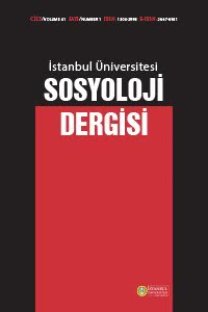Yerleşim Süresinin Avustralya'daki Türk Göçmenlerin Entegrasyon Seviyesine Etkisi
Göçler yolu ile meydana gelen veya uluslararası göç alan toplumların temel ilgisi farklı kültürlerin birbirleri ile uyum içerisinde yaşamasını sağlayabilmektir. Birbirleri ile uyumlu-ahenkli bir toplum, göçmenlerin entegrasyonu ile gerçekleştirilebilir. Entegrasyon, göç edilen ülkede yaşama süresi ile yakından ilişkilidir. Bu makalede Türk göçmenlerin Avustralya'da yerleşme süreleri göz önünde bulundurularak entegrasyon seviyelerine ilişkin bir analiz yapılacaktır. Bu çalışmada literatür taraması ve saha araştırmasının sonuçları yer alacaktır. Literatür taraması kısmında Avustralya'nın ve Avustralyalı Türklerin göç hikayeleri tarihsel olarak incelenecektir. Saha araştırması bölümünde, Sydney'de 152 Türk göçmene uygulanan anket sonuçları değerlendirilecektir. Çalışmanın sonunda, Türk göçmenlerin entegrasyonunun tamamlanmadığı görülmektedir.
Anahtar Kelimeler:
Göç; Yerleşme Süresi; Saha Araştırması; Türk Göçmenler; Avustralya
The Effect of Settlement Duration on Integration Levels of Turkish Immigrants in Australia
The main concern of the societies that occur through migrations or take international migrations is to create harmonious societies. The harmonious society can be created as a result of integrating the immigrants within the community. Integration is closely related to the settlement duration besides other factors. This article aims to make the analysis of the integration level among Turkish immigrants in Australia depending upon their settlement durations. This study includes literature research as well as field research. In the part of literature research, the case of Australia's migration and the migration story of Turkish people will be discussed from a historical perspective. In the field research, the results of the survey conducted to 152 Turkish immigrants living in Sydney will be discussed. At the end of the study, it has been shown that the integrations of Turkish immigrants are not completed.
___
- Abadan-Unat, N. (2006). Bitmeyen göç: Konuk işçilikten ulus-ötesi yurttaşlığa, İstanbul: Bilgi Üniversitesi.
- Adıgüzel, Y. (2010). Diyasporadaki kimlik algılamalarına göç tipinin etkisi: Almanya ve İngiltere Türk toplumlarının karşılaştırılması, Sosyoloji Dergisi, 20, 97-119.
- Australian Ethnic Affairs Council (1977). Australia as a multicultural society - Submission to the Australian Population and Immigration Council on the Green paper, Immigration policies and Australia’s population. Canberra: Australian Government Publishing Service.
- Australian Multicultural Advisory Council (2010). The People of Australia: The Australian Multicultural Advisory Council’s Statement on cultural diversity and recommendations to government, n.p.
- Babacan, H. (2001). Turks. J. Jupp (Ed.), The Australian people, an encyclopedia of the nation: Its people and their origins (pp. 781-782). Cambridge: Cambridge University.
- Day, A. (2003). Historical dictionary of the discovery and exploration of Australia. Lanham, Maryland and Oxford: Scarecrow.
- Eliot, T. S., (1948). Notes towards the definition of culture. London: Faber&Faber Ltd.
- de Haas, H. (2007). Migration and development: A theoretical perspective. Paper presented at the conference of “Transnationalisation and Development(s): Towards a North-South Perspective”, Center for Interdisciplinary Research, Bielefeld, Germany, May 31 - June 01, 2007, (Working Papers – Center on Migration, Citizenship and Development; 29) Bielefeld: COMCAD.
- Icduygu, A. (1994). Facing changes and making choices: Unintended Turkish immigrant settlement in Australia. International Migration, 32, 7193. doi: 10.1111/j.1468-2435.1994.tb00516.x
- İnan, A. M., (2012). Çok-kültürlülük tartışmaları bağlamında Avustralya’da yaşayan Türklerin kimlik algısı. Unpublished MA Thesis, Istanbul University.
- International Organization for Migration, (2010). World Migration Report 2010 The Future Of Migration: Building Capacities For Change. Geneva: International Organization for Migration.
- Jupp, J. (2002). From White Australia to Woomera The Story of Australian Immigration. New York: Cambridge University Press.
- Jupp, J., (2007). The Quest for Harmony. J. Jupp, J. Nieuwenhuysen, and E. Dawson (Ed.), Social Cohesion in Australia (pp. 9-20). New York: Cambridge University Press.
- Khoo, S., (2011). Intermarriage, integration and multiculturalism: A demographic perspective. J. Jupp and M. Clyne (Ed.), in Multiculturalism and integration: A Harmonious Relationship, (pp. 101-119). Canberra: ANU E Press.
- Manderson, L. and Inglis, C. (1984). Turkish migration and workforce participation in Sydney, Australia, International Migration Review, 18 (2), 258-275.
- Markus, A., Jupp, J. and McDonald, P. (2009). Australia’s immigration revolution. Crows Nest: Allen&Unwin.
- Ravenstein, E. G. (1889). The laws of migration, Journal of the Royal Statistical Society, 52 (2), 242-305.
- Stouffer, S. (1940). Intervening opportunities: A theory relating mobility and distance, American Sociological Review, 5 (6), 845-867.
- Tavan, G., (2005). The long, slow death of White Australia. Carlton North: Scribe.
- Tekeli, İ. (1975). Göç teorileri ve politikaları arasındaki ilişkiler, ODTÜ Mimarlık Fakültesi Dergisi, 1 (1), 153-176.
- West, B. and Murphy, F. (2010). A Brief History of Australia. New York: Facts on File Inc.
- http://www.abs.gov.au/ausstats/abs@.nsf/Lookup/2071.0main+features902012-2013
- http://www.immi.gov.au/media/fact-sheets/20planning.htm#b
- http://www.migrationheritage.nsw.gov.au/belongings-home/aboutbelongings/australias-migration-history
- http://www.immi.gov.au/media/publications/statistics/comm-summ/_pdf/turkey.pdf
- ISSN: 1304-2998
- Başlangıç: 2020
- Yayıncı: İstanbul Üniv. Edebiyat Fak. Sosyoloji Böl.
Sayıdaki Diğer Makaleler
Ağrılı Göçmenlerin Fransa'ya Tutunma Stratejileri
Antalya'daki Rus Gelinler: Göçten Evliliğe, Evlilikten Göçe
Göçmen İşçinin Sıla Hasreti: Bir Yabancılaşma Hikayesi
Dayanışma Ağları Üzerinden Eskişehir'de Siyaset ve Göçmenlik Algısı
Sosyometrinin Doğuşu ve Gelişimi
Alikoç Köyü (Makedonya) Özelinde Kadının Evlilik Göçü
Yoğun Göç Almış Metropollerde Etniklik ve Öteki ile İlişki
Kayseri Örneği Üzerinden Kentleşme ve Şiddet İlişkisi: İleriye Dönük Bir Projeksiyon
Altay AKTÜRK, Aylin YAKUPOĞLU, Dilek ÇELİK, Gökhan ORAL
Karşı İstikametten Göç: Türkiye'deki Yüksek Vasıflı Alman Kadınlar
Avrupa Toplumlarının Göç Algıları ve Tutumları: Sosyolojik Bir Yaklaşım
